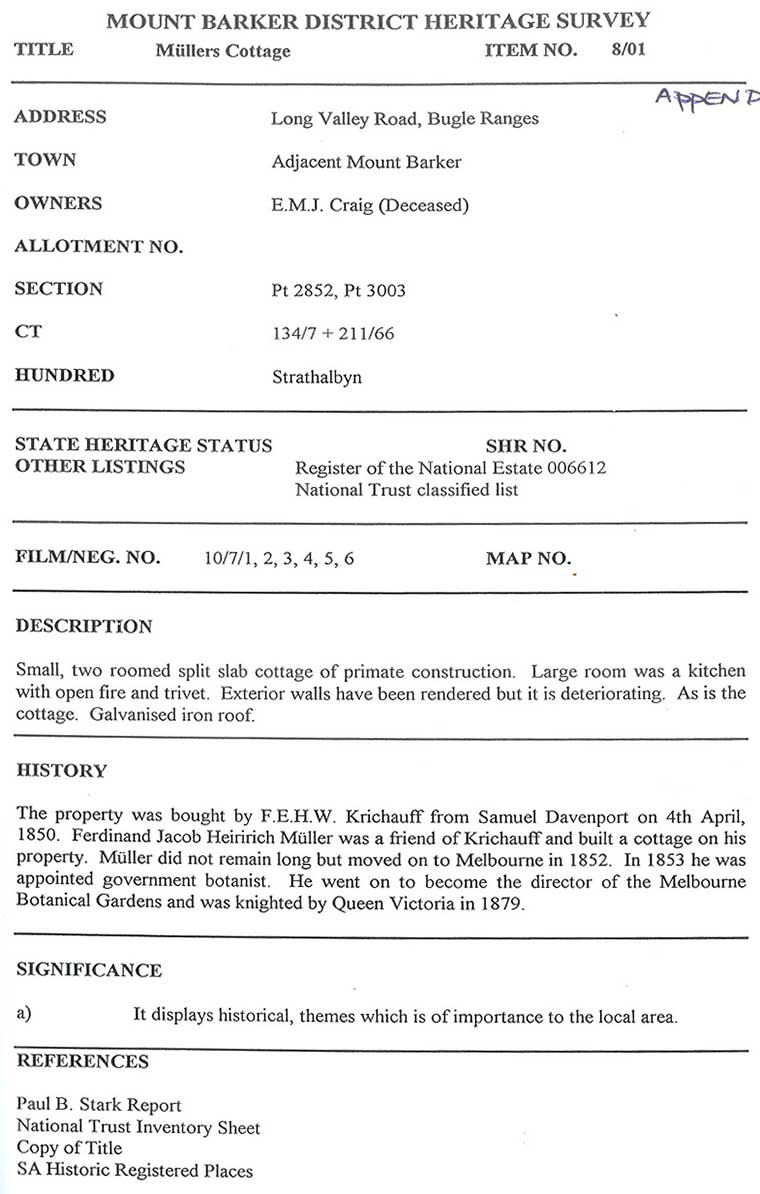Mueller's Cottage
Booklet: Mueller's Cottage, by John Gitsham
The following is as close a copy as manageable of the booklet researched and written by John Gitsham, of Macclesfield, published in 2013. The author has a personal interest in the cottage at Bugle Ranges as he lives in Macclesfield, which is only seven kilometres from the famous cottage. John is a member of the local Bushcare Group.
The full title of his booklet is: "Baron Ferdinand Von Mueller: An overview of his life in Adelaide, botanical work and his cottage in the Bugle Ranges, South Australia from 1847-52."
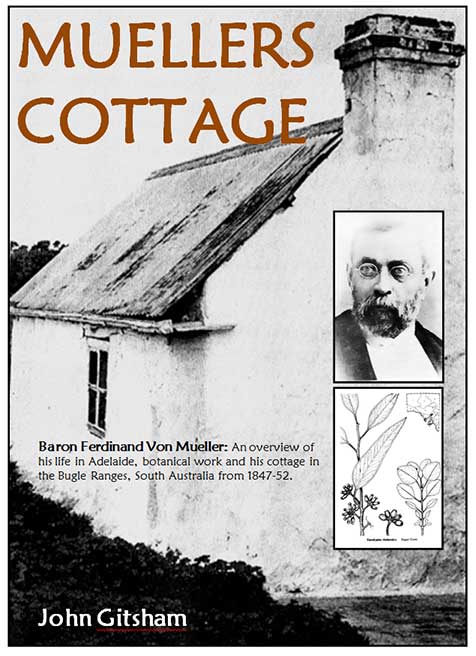
Introduction
Botany and botanists have a lot to thank the eccentric Ferdinand von Mueller for his name is to be found on hundreds of Australian plants, trees and shrubs. He was probably the most important botanist to visit Australia after Joseph Banks who came out with Captain Cook on the first fleet in 1770.
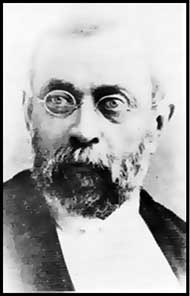
Photo of Mueller in the early
1890’s in Victoria, where he
died in 1896
Ferdinand Von Mueller was born Ferdinand Muller, on June 30th, 1825 in Schleswig-Holstein, in an area under disputed ownership bordered by Germany and Denmark.
He arrived in Australia on Dec 15th, 1847 at Port Adelaide on the ship ‘Hermann von Beckerath’, having left Germany for various health reasons.
Mueller lived and worked in and around South Australia doing botanical taxonomic studies. While living in South Australia he purchased and lived in a small cottage in the Bugle Ranges “Mueller’s Cottage”, which still stands today on a private farming property in the Adelaide Hills. (Pacsoa, 2005, www.pacsoa.org.au)
At the end of 1852 he moved to Melbourne to take up the position of director of the Melbourne Botanical Gardens.
He travelled around Australia extensively, collecting plant and animal specimens and classifying them for the scientific world. The ramifications of some of his work had practical benefits to Australian agriculture. He was also infamous, unfortunately, for introducing Blackberries to Australia, which have since become an environmental pest plant. (Pacsoa, 2005, www.pacsoa.org.au)
Throughout Mueller’s time in Australia his botanical work accumulated to include over 2,000 species of identified plants. He was responsible for distributing many plants and seeds to public gardens, herbaria’s and institutes throughout Australia and overseas, to boost their collections of Australian plants. Blue Gums in California can be attributed to von Mueller, although again this retrospectively may not have been such a great idea as this tree is now a major pest plant in the USA.
He became president of ‘The Acclimatization Society of Australia’ for 10 years while living in Melbourne, a group that believed that all and any plants and animals should be introduced to Australia to enhance the species already here. This group’s philosophy has caused huge damage to Australia’s ecosystems and to his credit when von Mueller started to realize this, he left the society, probably feeling rather guilty about his association with them because of his blackberry introductions and others.
Von Mueller and the Surveyor General of South Australia, Goyder, are thought to be the fathers of plantation forestry in Australia, Mueller planting well over 30,000 trees in his lifetime. He was the first to plant Marram Grass to help stabilize and anchor sand dunes, a technique that still is being used today. (Pacsoa, 2005, www.pacsoa.org.au)
Mueller became internationally recognized for his positive botanical work, and was awarded the status of Baron by the King of Germany (Wurttemberg) for his contributions to the field and large donations of botanical specimens from Australia.
His official title was of Baron “in order of the Olga” (The Queen of Wurttemberg was called Olga). The unique mountain range behind Uluru now known as Kata Tjuta was once named “the Olgas” in Mueller’s honour by the famous explorer Ernest Giles. (Pacsoa, 2005, www.pacsoa.org.au)
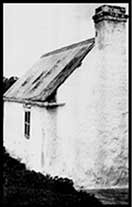
Ferdinand von Mueller was a significant botanist in Australia, whose name can be found accredited to many plants that are taxonomically listed. There are also many place names, roads and creeks named after him. He played an important role in recording South Australia’s early natural history.
Living in Adelaide, SA 1847-1852
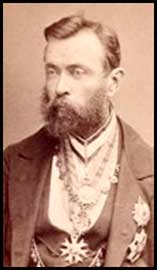
Photo of Mueller taken
in 1876 by J. W. Lindt.
La Trobe Picture
Collection, State Library
of Victoria
Plants play a basic part in Pharmacy, and Mueller studied botany and collected plants while he studied for his degree in Pharmacy in Germany. An outstanding student, he was awarded his PhD in Botany at the young age of 21 in 1846.
One year later he and his two sisters set sail to South Australia. Adelaide was the obvious choice, because there were two thriving German settlements in South Australia, at Klemzig and at Hahndorf in the Adelaide Hills. They were fresh, young and convict- free settlements, holding the promise of new adventures for a young German Botanist.
Ferdinand von Mueller and his two sisters Bertha and Clara arrived via sailing ship at Port Adelaide on Dec.15th. 1847. The ship "Hermann von Beckerath" departed from Bremen via Rio de Janeiro and the Cape of Good Hope in wild storms, arriving on the shores of Spencer Gulf which was alight with wild bush fires, but this did not stop the young Mueller from collecting plant samples, including sea weed samples from over the side of the ship and other plants from the waters edge while the passengers were unloading. (Home, 1998 p.19)
On arrival, Adelaide initially looked disappointing to the Mueller’s as it was only a small town compared to the great cities of Germany. They were in a new country, vulnerable and nervous, but as luck would have it they were approached by a well-dressed English gentleman named Samuel Davenport, (who would later play a major role in their life in South Australia, particularly in the purchase of the Bugle Ranges cottage). He was in the crowd-watching people disembark from the ship and noticed the Mueller’s. Davenport felt sorry for them and offered them accommodation at his home in Beaumont until they could find their own living quarters.
The Mueller’s soon became friends with Davenport and his wife and remained so for the rest of their lives. Davenport was also a patron to Mueller’s work throughout his life and maintained correspondence with him until Mueller’s death in1896.
Meeting the Davenport’s was not the only good luck they experienced. They met a man named Heinrich Heuzenroder who had travelled on the Hermann von Beckerath to South Australia to join his brother who owned and ran a chemist shop in Rundle Street, Adelaide. Through his contact with Heinrich, Mueller was able to procure employment immediately on arrival in the chemist shop, earning 15 shillings per week. (Kynaston 1981 p. 63/64)
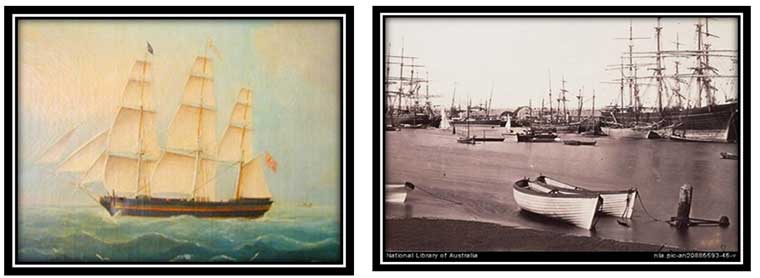
The ship Hermann von Beckerath and Port Adelaide in 1847, below the Cabin Passenger list showing Von Mueller and his sisters names and ages.

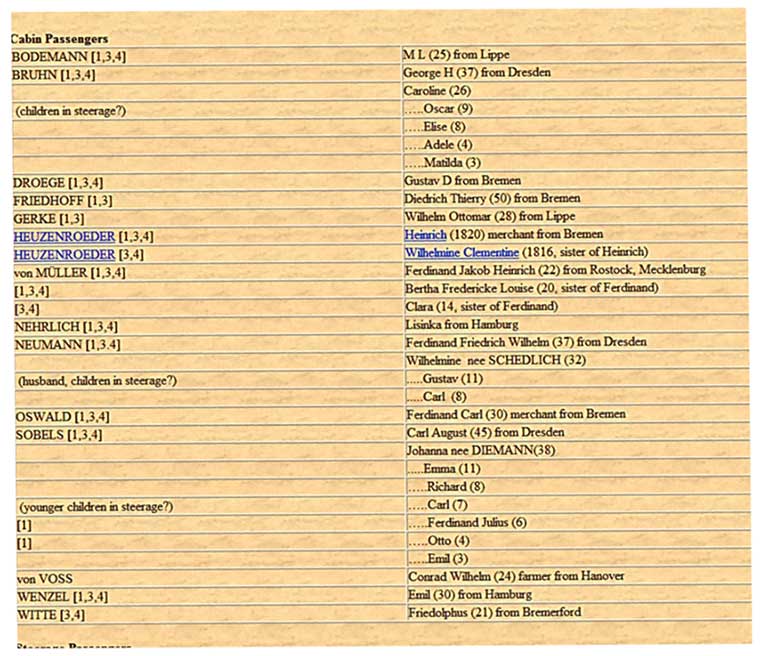
Mueller had more opportunities for plant study and discovery than he could have hoped for, and most of his spare time was spent walking around Adelaide and in the foothills of the Mt. Lofty Ranges, collecting specimens. He favoured walking as a means of travel, becoming an accomplished and hardened bushman, which helped him in his later journeys further a field in South Australia and Australia. Mueller’s sisters Bertha and Clara played an important role in pressing his plant specimens for his now growing collection.
Soon after arrival in Adelaide Mueller became a naturalized Australian, possibly prompted because you had to be an Australian citizen if you wished to purchase land. (Kynaston 1981 p. 67)
A notice in The South Australian Register of Adelaide proclaimed: "Naturalisation of Aliens: No.90., Ferdinand Jacob Heinrich Mueller, Colonial Secretary’s Office. 14th. August 1849".
He purchased a property in the Bugle Ranges and built the cottage that still stands today, but found the farming life distracted him from his botany obsession. He returned to his job as pharmacist at the Rundle St. chemist shop so he could indulge more in plant collecting on his days off. Mueller visited his cottage frequently when collecting plants throughout the Adelaide Hills and while visiting his sisters, who had moved to Macclesfield to live with the Davenport’s (they owned several houses).
Between 1850 and 1852 Mueller published numerous papers describing his work first starting in South Australia but soon publishing many of them in Germany and England. He published in The South Australian Register one of his earliest papers called "Notes on South Australian Botany". (Kynaston 1981 p. 69)
He placed an advertisement in the local paper in an attempt to raise funds to pay for his scientific work, because at the time the Government was not interested in sponsoring his ventures, and rallied funding from the public as well as his good friend Samuel Davenport.
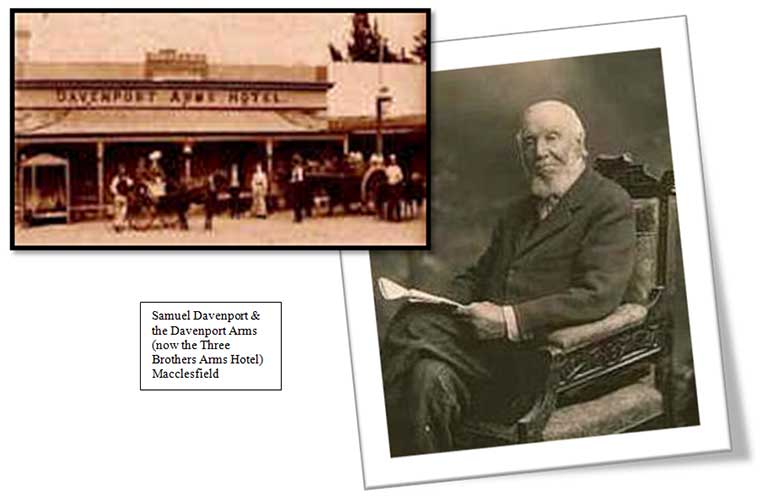
Samuel Davenport and the Davenport Arms (now the Three Brothers Arms Hotel) Macclesfield
Mueller produced hundreds of remarkable scientific papers about Australia’s botany throughout his lifetime. The world of Botany was sitting-up and taking notice of this little German man working from Adelaide. Over 170 International and National acknowledgments and awards would later be bestowed upon him, and he enjoyed the attention, cherishing the honours and the accolades he received at ceremonies. By the time he died in 1896 he had gained the impressive title of Baron Sir Ferdinand Jacob Heinrich von Mueller. (Kynaston 1981 p. 4)
He was a prolific letter writer and wrote thousands of letters to all kinds of professional people throughout his life (he wrote about 2000 letters per year and exchanged thousands of seeds and plants with fellow botanists around the world (Pacsoa, 2005, www.pacsoa.org.au)). Attached are two examples of letters he received from notable correspondents Charles Darwin and the explorer Charles Stuart (Appendix one a/b). (Kynaston 1981 p. 70)
It is interesting to note that when Charles Darwin published “Origins of Species”, Mueller could not reconcile evolution with the Lutheran religious views to which he was strictly devoted. (Pacsoa, 2005, www.pacsoa.org.au)
Mueller’s botanical work was mainly phytogeographical and taxonomic in style. Unlike other botanists working in Australia at the time, Mueller was not content to send his samples back to the experts in Europe for identification and description, but was determined to publish his own work. Mueller formulated a plan to prepare a flora of South Australia, a major work that is still used today by botanists.
By 1852 Mueller’s work was being noticed by the right people as his botanical work was of the highest quality. Finally the pressure was on him to move to Victoria to head the Melbourne Botanical Gardens as the Director, although this would become a controversial appointment as he was a stubborn and pedantic perfectionist and would seven years later be asked to resign from the position. He left Adelaide for Melbourne in August 1852. (Home, 1998 p.20)
The Botanical work in South Australia.
Dr. Ferdinand Von Mueller (later Baron) was one of Australia’s finest botanists of the 19th Century. He scientifically identified and named many hundreds of plants and trees. (Of course these had been very well known to local indigenous groups throughout Southern Australia under different names for many thousands of years, so his work was only significant to the European (Western) scientific community and botanists of the world). He worked extensively around South Australia from 1847 until August 1852, before moving permanently to Melbourne, Victoria to take up the position of Director of the Melbourne Botanical Gardens.
The first native plant he obtained and identified on Australian soil was Helichrysum leucopsideum, on Le Fevre Peninsula on 16th December 1847. (Kraehenbuehl, 1996 p.26)
Von Mueller was an energetic traveller who roamed the countryside visiting many SA country towns, such as Bethany, Tanunda from 12-15th April 1848 and Lake Alexandrina on the 27th April 1848.
In September of that year he travelled to the Barossa Ranges and Wellington near the mouth of the Murray River in October of 1848. While in that area he visited the South East at Mount Burr and Mount Muirhead, coming back to the Bugle Ranges to sort through the specimens he had collected.
Throughout most of 1849 Mueller was engaged in farming on his property at the Bugle Ranges, but was still able to find some time to travel to the SE again, to Guichen Bay and Cape Jaffa. In 1850 he travelled to the Rhine River, Tillys Range and Biscuit Flat, and Rivoli Bay in September of that year.
It is also believed that he made his first trip towards the Flinders Ranges in that year, reaching Mt. Remarkable. This would be followed by several trips to the Flinders Ranges in later years. (Kraehenbuehl, 1996 p.26)
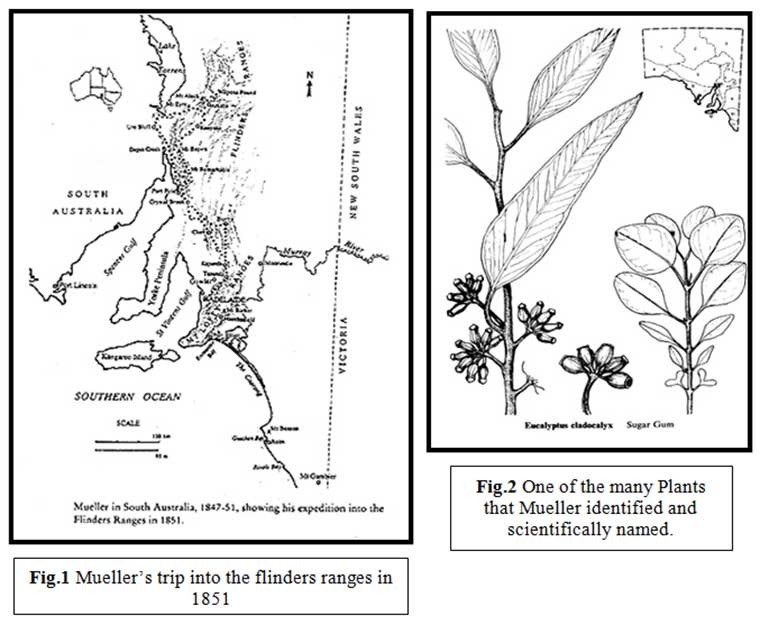
The year of 1851 (fig.1) was notable for von Mueller’s most remarkable and arduous expedition, plant collecting through the Flinders Ranges. From October 7th through to the 7th November he travelled to Crystal Brook, Nelshaby and Mount Remarkable, and then to Cudnaka and Arkaba in the northern Flinders. Later that year he travelled to the River Murray, Moorundie and down to the South East to Guichen Bay again. Apart from a few trips along St. Vincent Gulf he did not travel far from the Mt. Lofty Ranges, River Torrens and Onkaparinga during 1852.
Later that year in August of 1852, he left for Melbourne to take up his newly appointed position at the Melbourne Botanical Gardens, as his reputation as a high quality botanist was now widely known. He rarely returned to South Australia in his later years. (Kraehenbuehl, 1996 p.27)
Listed below are only a few of the hundreds of plants he identified while travelling throughout South Australia. They can be identified easily by looking up the scientific name of the species in any Australian Plant book, where the initials ‘F. Muell.’ will be seen.
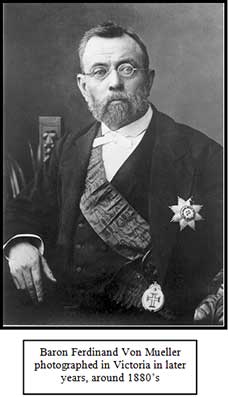
• Red Mulga Acacia cyperophylla
• Iron wood Acacia estrophiolata
• Dead-Finish Acacia tetragonophylla
• Whitewood Atalaya hemiglauca
• Bean Tree Bauhinia carronii
• Desert Kurrajong Brachychiton gregorii
• White Cypress Pine Callitris columellaris
• Desert Oak Casuarina decaisneana
• Long-leaved Eremophila Eremophila longifolia
• Broad-leaved Box Eucalyptus behriana
• Sugar Gum Eucalyptus cladocalyx (fig.2)
• Cup Gum Eucalyptus cosmophylla
• Pink Gum Eucalyptus fasciculosa
• Yorrell Eucalyptus gracilis
•
SA Blue Gum Eucalyptus leucoxylon
• And many more…(Boomsma 1981)
This sample of the extensive contribution that Mueller made to Australian Botany includes only species indigenous to South Australia. Mueller collected many more samples once he moved to Victoria.
Living in the Bugle Ranges (Mueller’s) Cottage.
In December of 1848, a year after the Mueller’s arrived in Adelaide; he was still working in the chemist shop in Rundle Street, which he had not found very enjoyable. He decided (along with a good friend and aided by Davenport) to purchase a block of land of about 20 acres at Bugle Ranges, 7 km east of Macclesfield in the Adelaide Hills. Mueller decided to take up farming as an alternative to working in the Chemist shop. He became a farmer and pioneer gaining the independence he had been craving. He could now collect plant specimens when he felt like it and go on expeditions when necessary. His sister Clara came up from Adelaide to house keep for him in the cottage, which was built in 1849 from locally cut timber. This adventure was not to last, however, as he would end up working back at the Chemist shop once more.
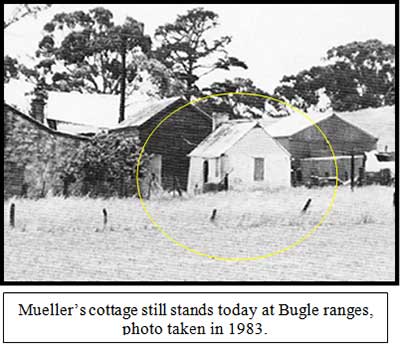
Mueller lost money on the Bugle Ranges property, but during his stays at the cottage his health improved, as he was a prolific walker, doing a lot of plant collecting while walking around the Adelaide Hills. (Kynaston 1981, p. 66)
The cottage still stands to this day, and is listed by the National Trust of South Australia, although it is unfortunately not in very good condition. Copies of current documentation about the cottage from the Mt. Barker Historical Society are attached (Appendix 5). Time has not been kind to the structure and it is now in a state of disrepair, but local historians are attempting to raise money so that the cottage can be restored to its former glory. The original hut was built from local Sheoak trees (Allocasurina verticulata), which were used for the uprights.
Mueller and fellow workers were nearly crushed to death by one of these trees, felled while the cottage was under construction. He later purchased a further 60 acres of land surrounding his cottage from his friend Samuel Davenport (on November 9th 1850). (Gemmell 1975, p. 6)
Attached (Appendix 2) is the floor plan of the original wattle and daub cottage. With Bertha Mueller living with Samuel Davenport at Macclesfield and Clara now living with Mr. and Mrs. Austin at ‘Lashbrook’ just outside of Macclesfield, Mueller (although living back in Adelaide, at times) would visit his sisters and stay in the cottage while in the area. He used it as a base when on his many collecting trips, both in the Adelaide Hills, to the Murray Mallee areas to the east and along the Murray River. (Gemmell 1975, p. 7)

Mueller’s Cottage,
Bugle Ranges, 1990
Von Mueller’s hut (as it became known to the locals) was made from the sheoak and red gum that were prolific in the area.
The large trunks were split into boards called ‘slabs’ and used vertically like a fence for the walls. The slabs were 20cm wide by 4cm thick and about 2m high. The doorway height was only 1.65m (Mueller was a small man), and gaps between the slabs were filled with a mixture of clay and water, a technique called ‘pugging’.
The finish on the walls was a lime wash. Over the years the walls through successive coatings of lime and clay became thicker.
The main room (2.8m square see photo of interior) was used as the kitchen and sitting room and was dominated by a large fire place (1.2m wide by 45cm deep). The fireplace and chimney projected through the roof against the gable walls. The sawn red gum planks were laid and butted together, becoming as the original floor, the interior floor made flush with the outside ground. (Mt. Barker Local History Centre, 2005)
The ceiling was constructed using hand-sawn planks, which became blackened overtime due to smoke from the fireplace. The original bark-thatched roof was replaced over time with corrugated galvanized iron, and the building still remains without a verandah. The tiny second room (2.8m by 2.0m) was the only bedroom as seen in the original layout (Appendix 2). The only furniture in the room was a large wooden trestle and benches.
Von Mueller’s cottage conforms to traditional pioneer house designs, although there are some subtle differences. He built the cottage (with the help of Krichauff) differently to the way a British builder would. Mueller being German sited the building on raised ground, oriented to the points of the compass with the chimney side wall (plain) facing northward.
This followed the traditional European practice of providing a thicker wall to the north, devoid of openings, to protect the occupants from the winter weather. He did not take into account that in Australia the winter weather comes mostly from the southwest! He would have realized his mistake however when the first winter came as he built the cottage during the summer.
Also, according to European customs, the only two doors open against the walls instead of into the room as they would in a British home.

Attached in Appendix 3 and Appendix 4 are ‘EBC research slips for historic buildings’, files from the National Trust of South Australia and a map of the area showing where Mueller’s cottage is today. (McEwin 1990 p.25)
The property over the years has changed hands first being sold to James McCall (a shepherd) of Bugle Ranges, then to A.J.R. Shepley and finally to Mrs. M.J. Craig in 1983*. While the exterior has become run-down the interior (right) is still in its original condition with the fireplace still intact and still being used for cooking until recently.
The time Mueller spent at the cottage was fruitful and enjoyable as he was surrounded by fellow botanists Krichauff and Fischer who also lived in the Bugle Ranges and Macclesfield during the five-year period when he lived in South Australia. (Stark, 1983 p.168). Even after this time he would sometimes return to the cottage following his field trips to the Flinders Ranges and other parts of Australia.
Many of the botanical specimens he collected from the Bugle Ranges, Macclesfield and Mount Barker Creek are still preserved in the Melbourne Herbarium, Victoria. (Faull, 1980 p.76)
* New owners since 2010 of Muellers Cottage property are John & Leonne Silman.
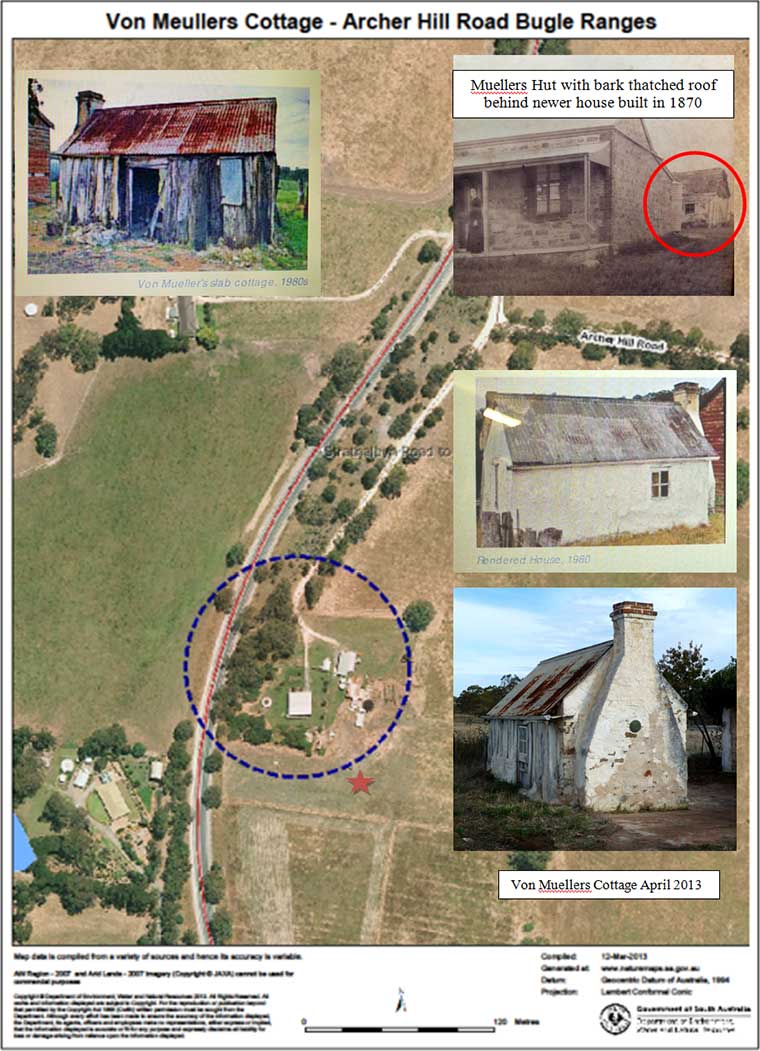
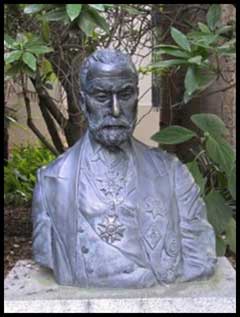
A bust of Mueller found in the
Melbourne
Botanical Gardens,
Victoria
Mueller passed away on Oct.10th 1896 in Melbourne, suffering a massive stroke. He is buried in the St. Kilda Cemetery, Victoria. Politicians, bureaucrats, and the simple folk of the colonial society were baffled and bemused by him. Because of his complex personality they thought he was a pretender and did everything to reduce him to their own mediocrity. So it is ironic that a granite obelisk, surmounted with an urn, was erected over his grave. The monument was one of the largest in the cemetery and some believed that its size was consistent to with the guilt his contempories and peers felt as a result of their treatment of the great man while he was alive (Kynaston, 1981 p.370)
Mueller was naturally a loving, gentle man. He found other people complex and a threat to him; hence he gave all his energy and love to the land. Although he was always kind, people remained only useful objects to him. His botany work was his refuge and salvation. While he was egocentric, perhaps his ways were sadly often touching and irresistibly funny to people around him.
For nearly fifty years, Mueller wrote continuously, producing tens of thousands of letters, a thousand scientific papers, and hundreds of speeches and lectures and over forty books. He wrote in German, Latin, English and French.
The author Edward Kynaston who wrote the biography (A Man on Edge: a life of Baron Sir Ferdinand von Mueller) says:
“His (Mueller’s) contemporaries described him to be fluent in several languages, but apparently he was not even fluent in German, it was said to be prosaic, cliche'd and undistinguished. His English was Latinate, ponderous, clumsy and dull. He had no feeling for words. Mueller was an atrociously bad writer. He was also a bad speaker, meandering on interminably until boredom and sleep overcame the back rows of his audiences, and the front rows strove politely to keep awake.” (Kynaston, 1981p.371)
Mueller believed that the time he had spent living and working on the land had restored his health and provided him with many opportunities that he would have been unable to find anywhere else in the world. Mueller wrote very little about himself, but many facts about his love of botany. (Kynaston, 1981 p.373)
Many rivers and mountains in Australia, New Zealand and Antarctica are named in memory of him, as are many plants, such as Calamus muelleri, Livistona muelleri and Heterospathe muelleri.
While Mueller may have been eccentric, egotistical and dull to some, Australian Botany and the scientific community have a lot to thank the devoted Baron Ferdinand von Mueller for, as without his magnificent efforts Australia would be scientifically poorer.
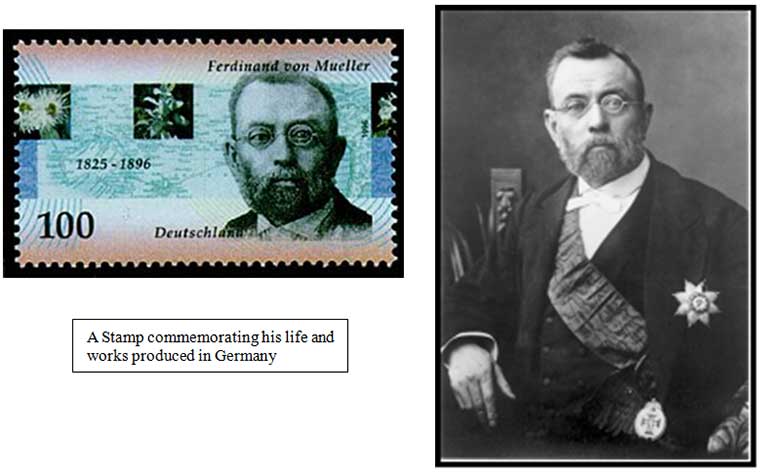
Artworks based on Mueller
Love, Death, Music and Plants, a music theatre work based on scenes from the life of Mueller, was written by Brian Lipson (writer) and Matthew Hindson (composer), and had a two-week season at the Mueller Hall, National Herbarium of Victoria, 18–30 November 2003.
Places named after Mueller
A number of geographical features were named after Mueller:
The Mueller Ranges (Western Australia)
Muellers Range (Queensland)
Mount Mueller (in WA, Northern Territory, Tasmania and Victoria)
Mount von Mueller (WA)
Muellers Peak (New South Wales)
The Mueller River (Vic)
Muellers Creek (South Australia) and Mueller Creek (NT)
Lake Mueller(Qld)
Mueller hut near the Mueller Glacier in New Zealand.
Mueller Park, Subiaco (WA) is also named after him.
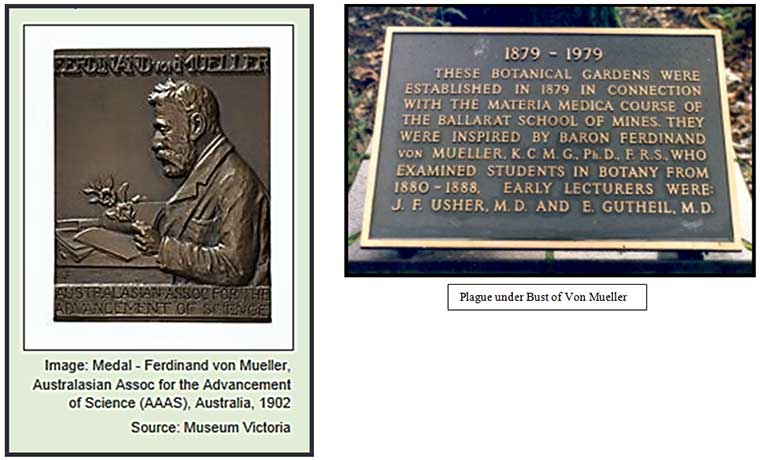
A Victorian Railways diesel-electric locomotive S311 is named after Mueller
Details: from http://vicsig.net/index.php?page=locomotives&number=311&class=S&type=Diesel-Electric&orgstate=V
Loco: S311
Serial/Builder's Number: 60-228
In service: Tuesday, 6th December 1960
Withdrawn: September 1993
Livery: CFCLA Silver and Blue
Owner: Chicago Freight Car Leasing Australia
Operator: El Zorro
Name: Sir Ferdinand von Mueller
Gauge: SG

Book and photograph from 1865
References
Boomsma, C.D., 1981, Native Trees of South Australia, Second Edition, pub. Woods and Forests Dept. Adelaide.
Faull, J. 1980, Macclesfield: reflections along the Angas, p.76, pub. Lutheran Publishing House, Adelaide.
Gemmell, N. 1975 Ferdinand von Mueller and the early settlement of Bugle Ranges
The South Australian Naturalist, vol. 49, number 4, p.6-7, June, 1975. pub. F.N.S.of SA.
German Australia, German-Speakers in Australia, 2005
http://www.germanaustralia.com/e/mueller.htm
Home, R. W. et al 1998, Regardfully Yours: Selected correspondence of Ferdinand von Mueller, Volume 1: 1840-1859, p.19-20, pub. European Academic Publishers, Bern.
Kraehenbuehl, D. N., 1996, Pre-European Vegetation of Adelaide: A Survey from the Gawler River to Hallett Cove, p.26-27, pub. Native Conservation Society of SA inc. Adelaide.
Kynaston, E. 1981, A Man on Edge: a life of Baron Sir Ferdinand von Mueller p.4, 66-67, 69-70, 370-371, 373.pub. Penguin books, Melbourne.
McEwin, G. G. 1990, Hundred of Macclesfield: Historical Search of titles, Alienation to Current. p.25, A 720.994232 MCE LH, Mt. Barker Library, Local History Centre, 2005.
Stark P. B. (Report), National Trust Inventory Sheet, Copy of Title, SA Historic Registered Places. Mt. Barker District Heritage Survey, Title: Mueller’s Cottage, Item no. 8/01.p.168, Mt Barker Library, Local History Centre, 2005.
Palm & Cycad Societies of Aust., People, 2005
http://www.pacsoa.org.au/places/People/mueller.html
Bibliography.
Australian National Botanic Gardens, Von Mueller F., 2005 available online
https://www.anbg.gov.au/biography/mueller-ferdinand.html
Boomsma, C.D., 1981, Native Trees of South Australia, Second Edition, pub. Woods and Forests Dept. Adelaide.
Costermans, L. 2005, Native Trees and Shrubs of South Eastern Australia, pub. New Holland Publishers, Sydney.
Faull, J. 1980, Macclesfield: reflections along the Angas pub. Lutheran Publishing House, Adelaide.
German Australia, German –Speakers in Australia, 2005 available online http://www.germanaustralia.com/e/mueller.htm
Gemmell, N. 1975 Ferdinand von Mueller and the early settlement of Bugle Ranges
The South Australian Naturalist, vol. 49, number 4, June, 1975. pub. F.N.S.of SA.
Home, R. W. et al 1998, Regardfully Yours: Selected correspondence of Ferdinand von Mueller, Volume 1: 1840-1859, pub. European Academic Publishers, Bern.
Kraehenbuehl, D. N., 1996, Pre-European Vegetation of Adelaide: A Survey from the Gawler River to Hallett Cove, pub. Native Conservation Society of SA inc. Adelaide.
Kynaston, E. 1981, A Man on Edge: a life of Baron Sir Ferdinand von Mueller pub. Penguin books, Melbourne.
McEwin, G. G. 1990, Hundred of Macclesfield: Historical Search of titles, Alienation to Current. A 720.994232 MCE LH, Mt. Barker Library, Local History Centre, 2005.
Palm & Cycad Societies of Aust., People, 2005 available online
http://www.pacsoa.org.au/places/People/mueller.html
Stark, P. 1983, Meadows Heritage pub. Gillingham Printers P/L, Adelaide.
Stark P. B. (Report), National Trust Inventory Sheet, Copy of Title, SA Historic Registered Places. Mt. Barker District Heritage Survey, Title: Mueller’s Cottage, Item no. 8/01. Mt Barker Library, Local History Centre, 2005
Appendices
Appendix one: Letters to von Mueller from Charles Darwin (a) and Charles Stuart. (b)
Appendix two: The floor plan of Mueller’s Cottage at Bugle Ranges & Photos.
Appendix three: EBC files National Trust of SA. Mt. Barker Historical Society.
Appendix four: Map of the Bugle Ranges area showing location of Mueller’s Cottage.
Appendix five: Documentation of Mueller’s Cottage from the Mt. Barker History Centre.
Appendix 1
Letters to von Mueller from Charles Stuart (a) and Charles Darwin. (b)
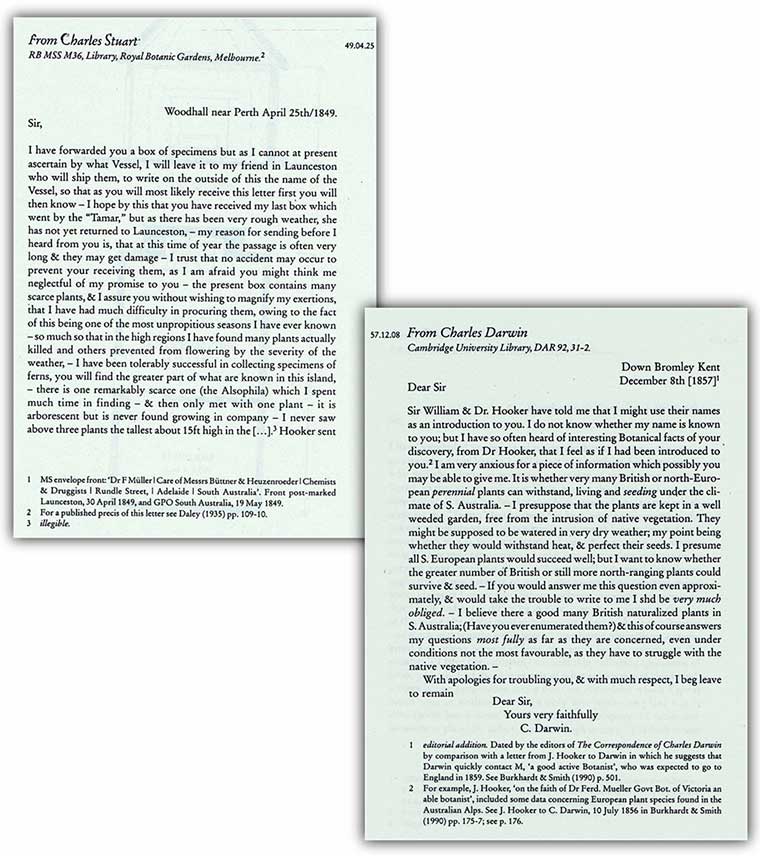
Appendix 2
The floor plan of Mueller’s Cottage at Bugle Ranges, and photos of the cottage.
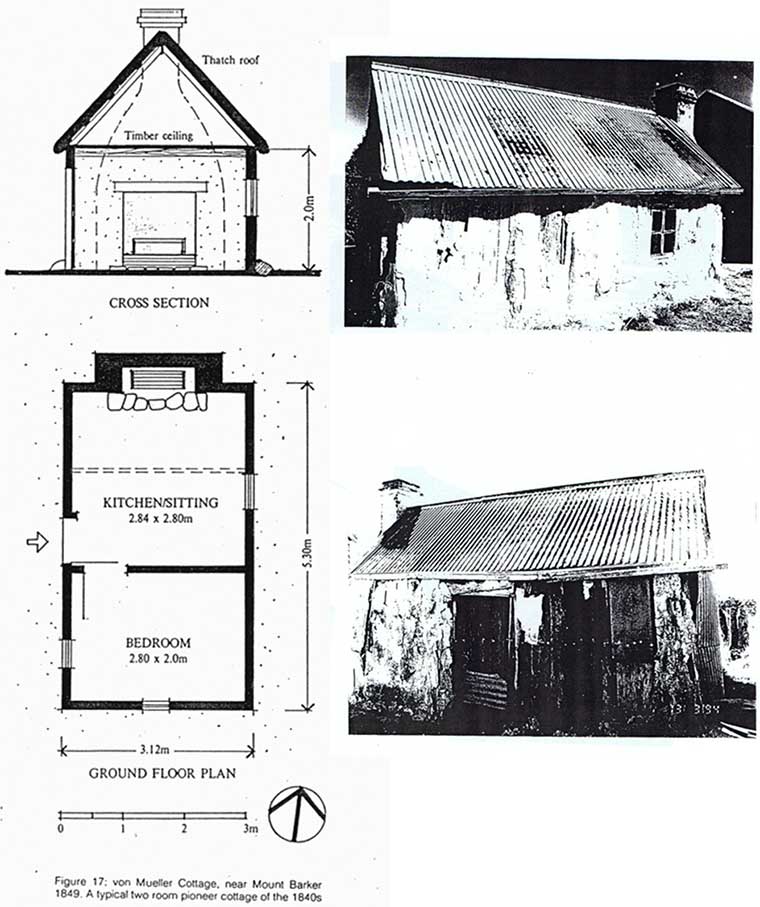
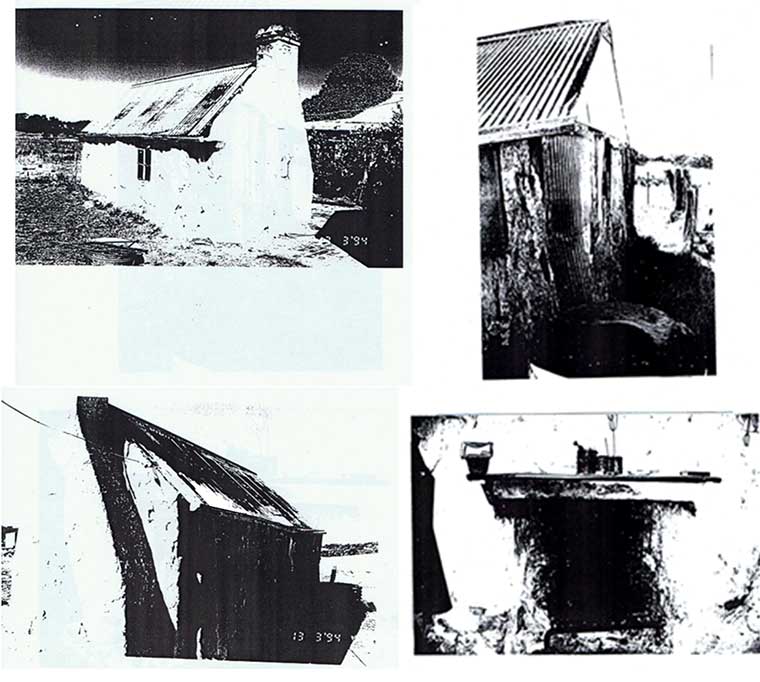
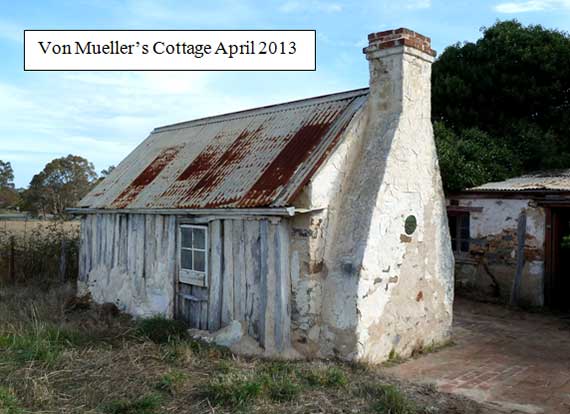
Appendix 3
EBC files National Trust of SA. Mt. Barker Historical Society
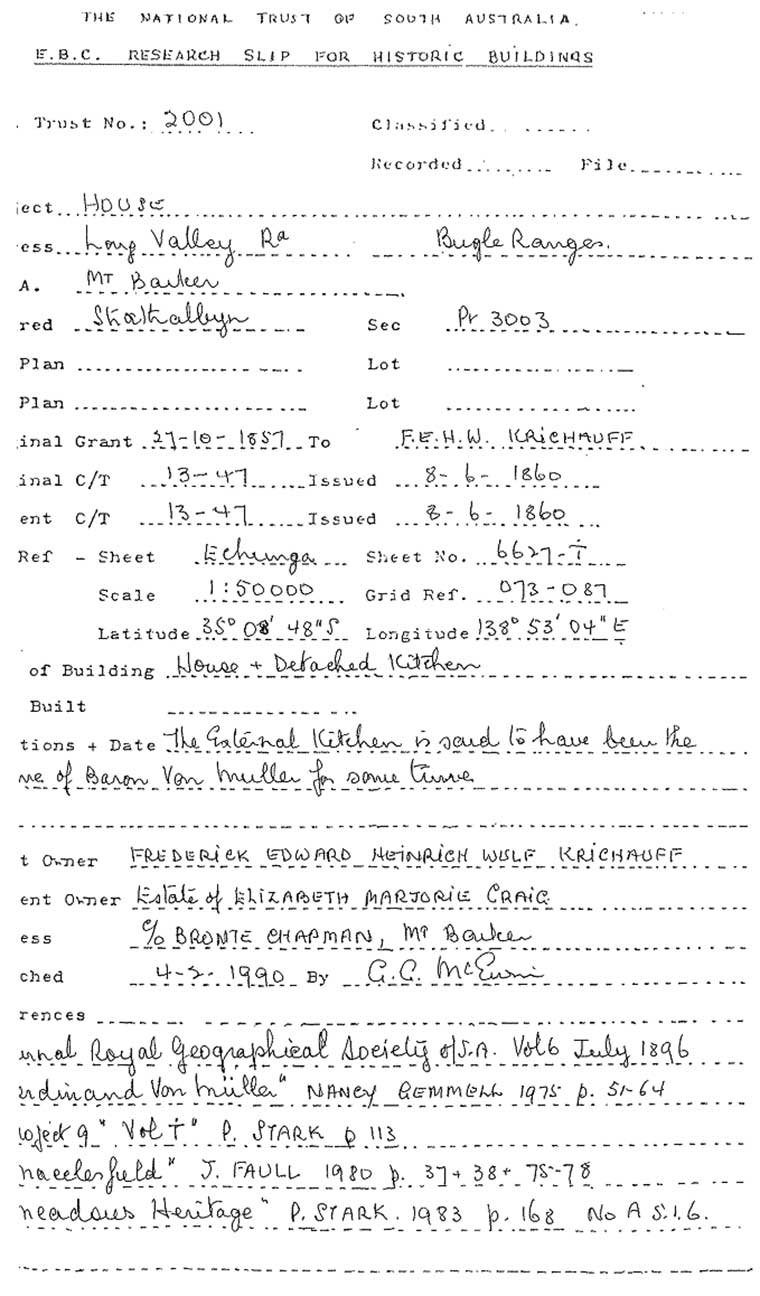
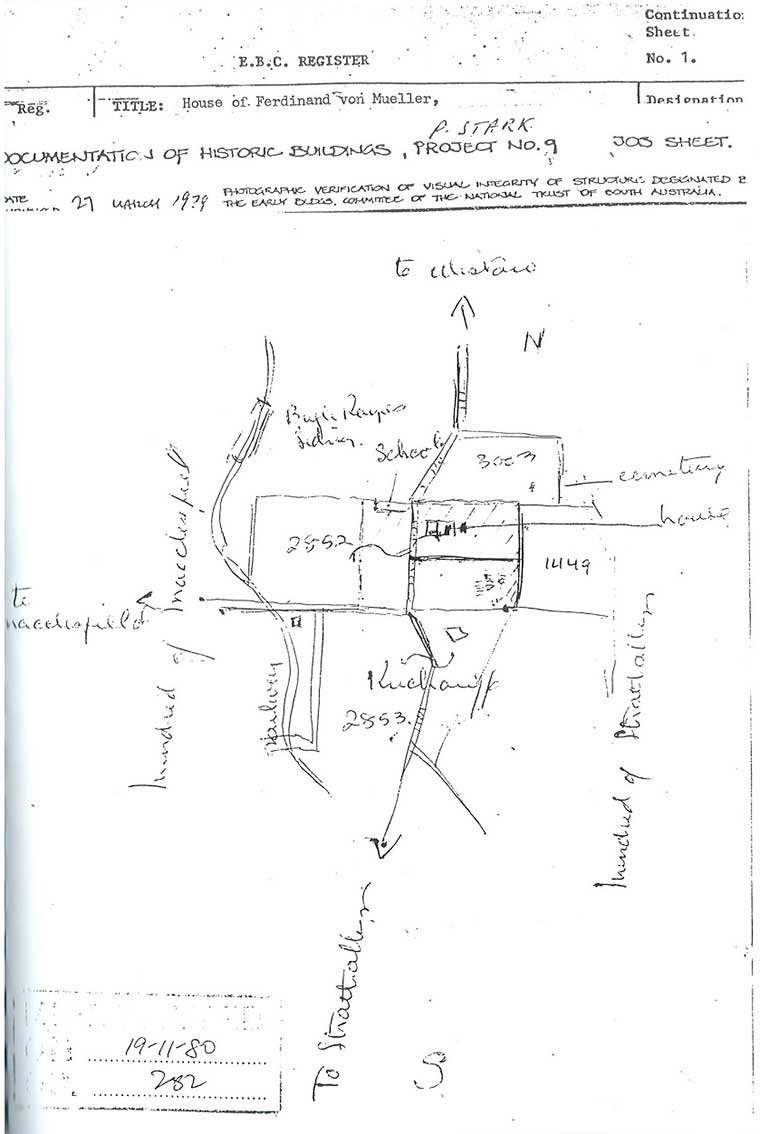
Appendix 4
Map of the Bugle Ranges area showing location of Mueller’s Cottage
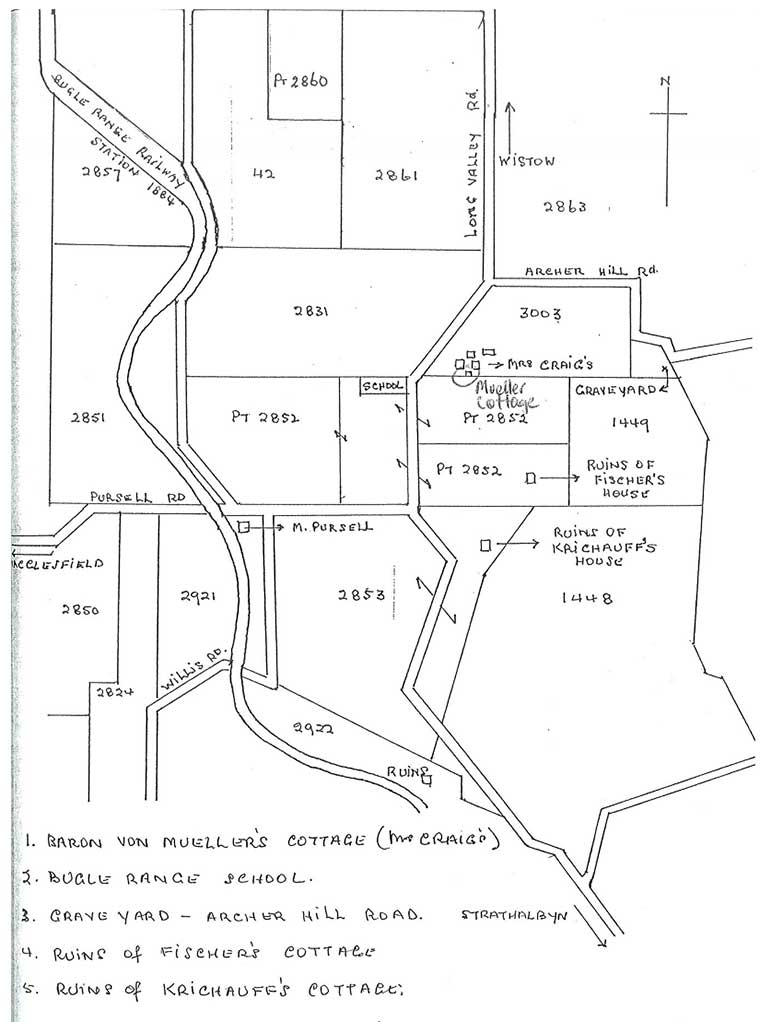
Appendix 5
Documentation of Mueller’s Cottage from the Mt. Barker History Centre
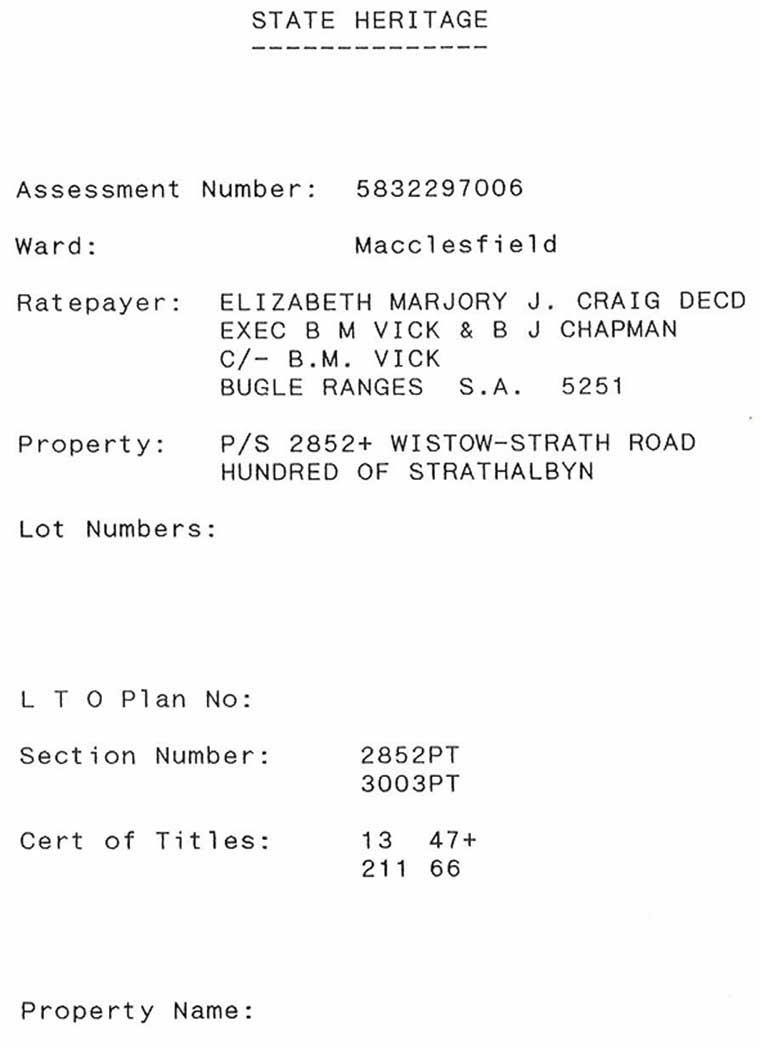
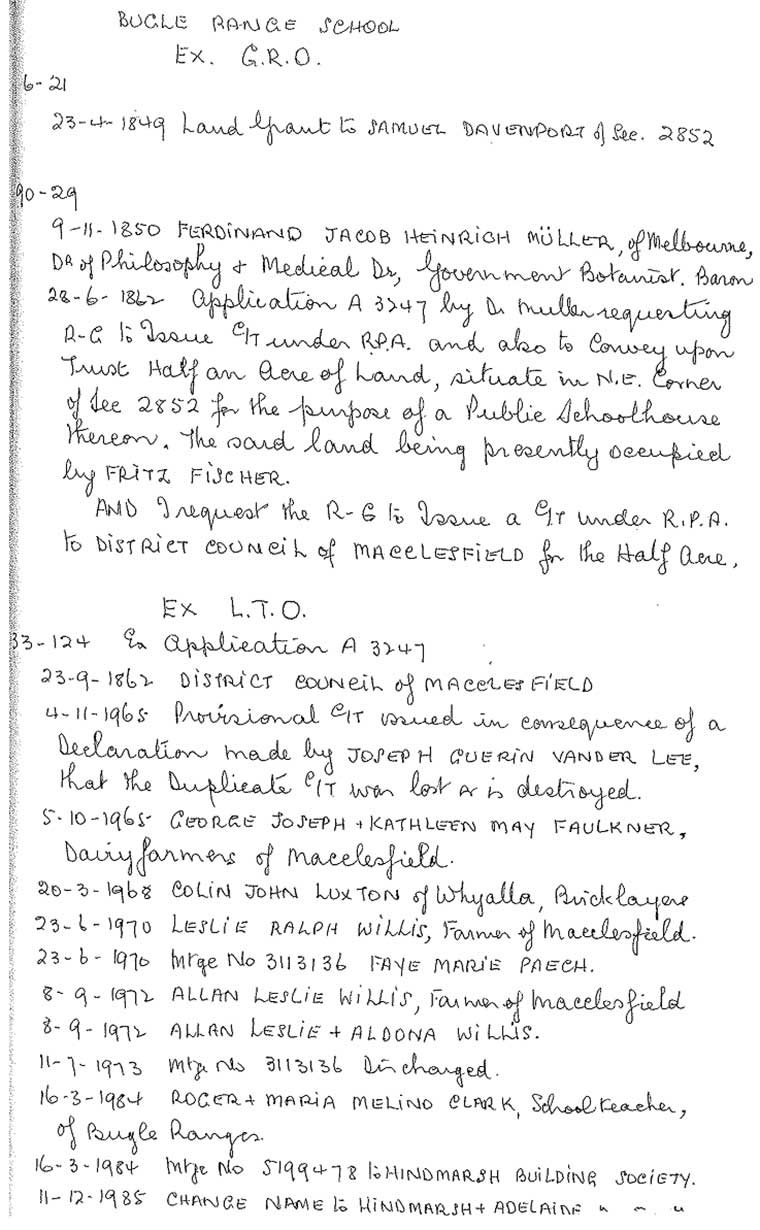
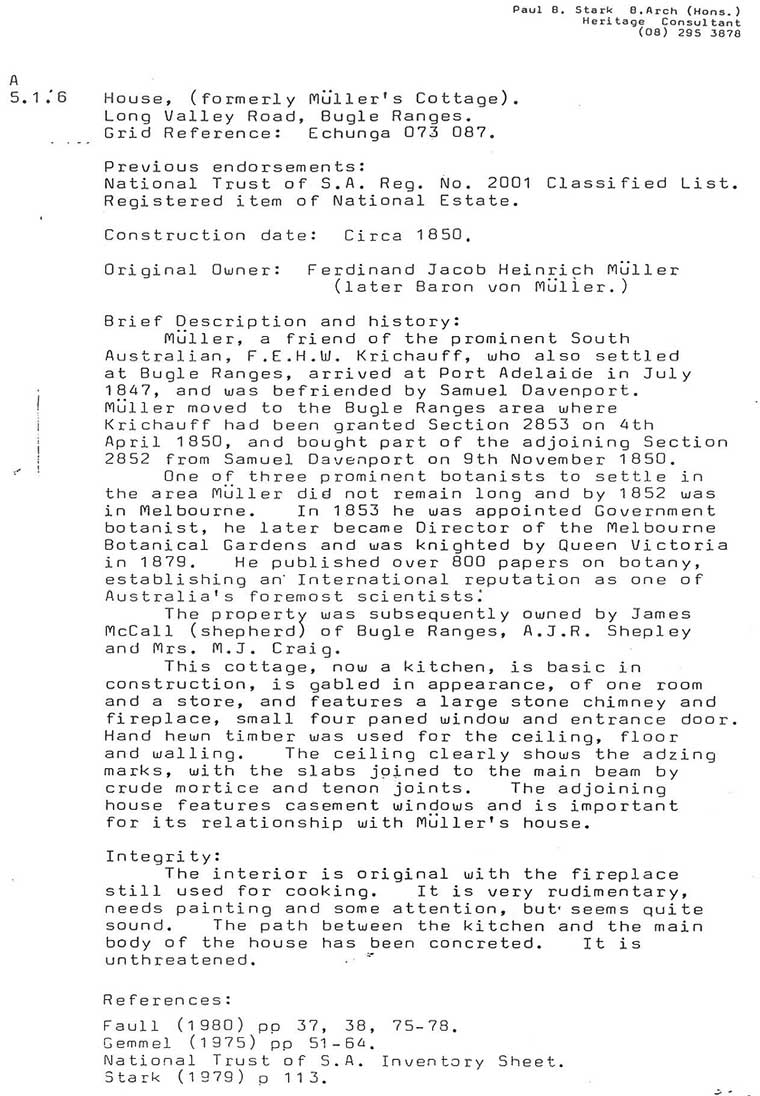
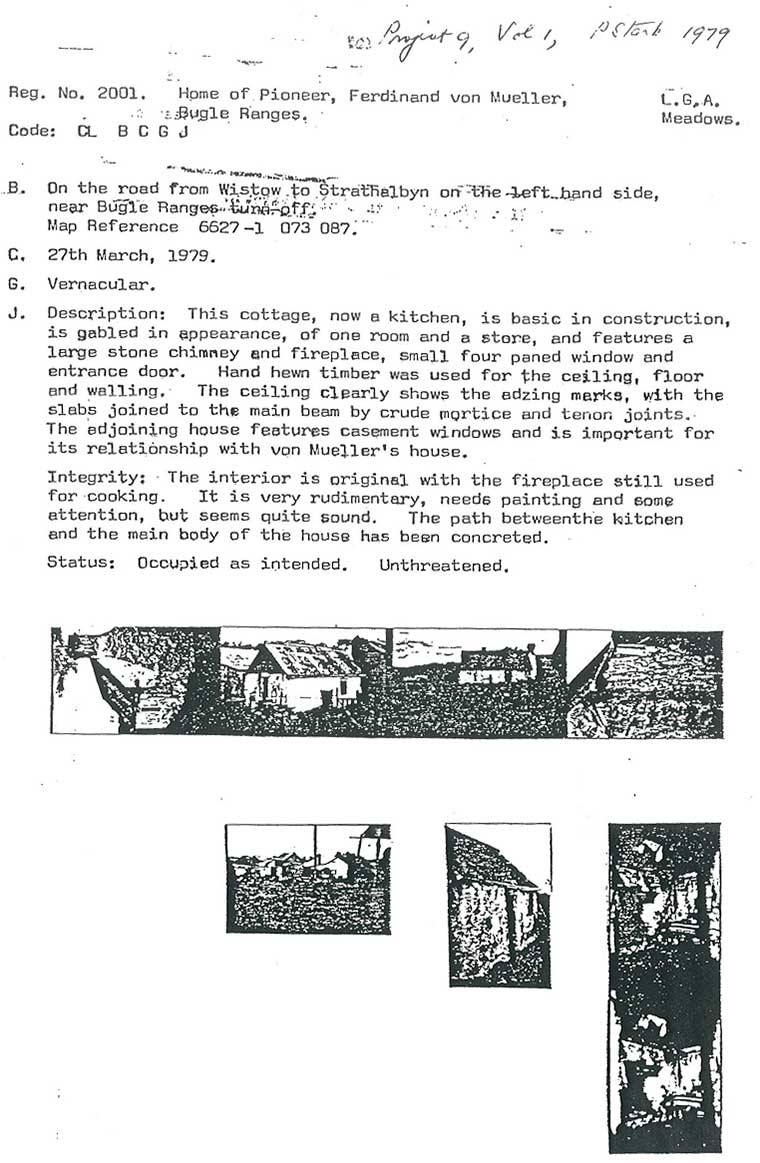
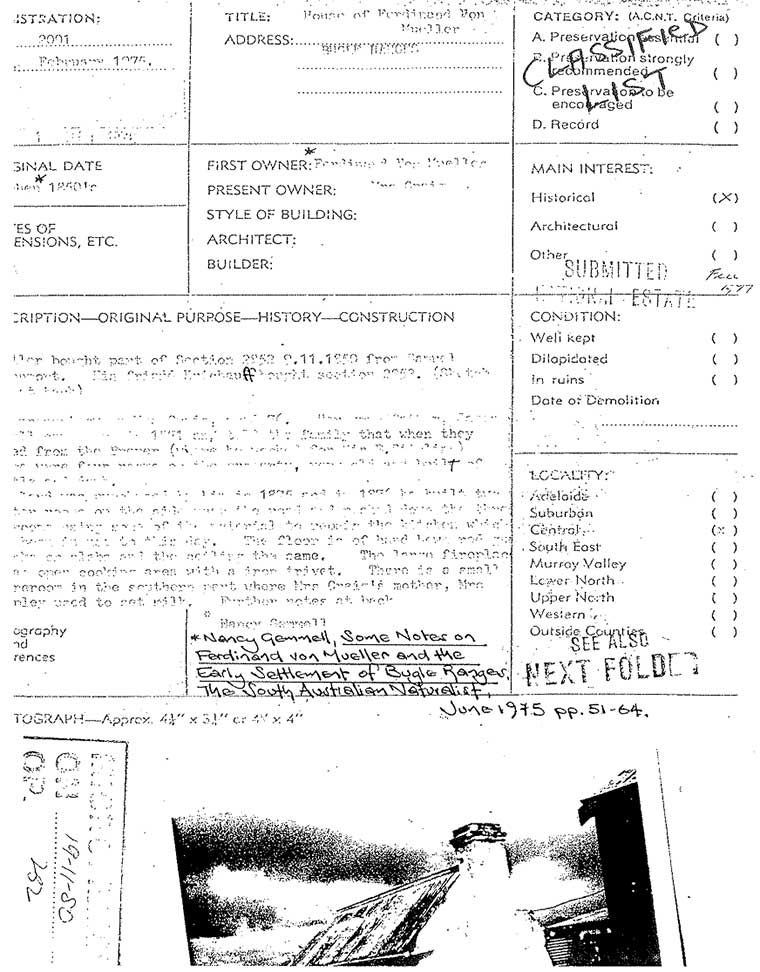
Mount Barker District Heritage Survey
